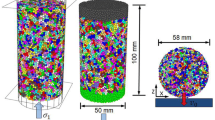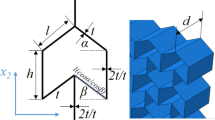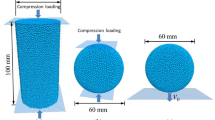Abstract
The normal coefficient of restitution (NCOR) is a useful index to quantify the energy dissipation during impact. This study presents experimental tests of marble spheres impacting a plate. The effects of the sphere diameter, elastic properties of the plate, impact velocity, and repeated impacts on the NCOR were investigated. Three fracture phases were observed: no macrocrack, macrocrack, and fragmentation. A clear influence of the propagation of the macrocracks on the NCOR was observed. Macrocracks also cause increased NCOR variability. The cumulative damage caused by macrocracks can affect the propagation of macrocracks and fragmentation. In the no macrocrack phase, the NCOR decreases with increasing velocity and with decreasing diameter, and the velocity effect of the NCOR is also related to the size of the marble sphere. The proposed average rate of contact stress correlates well with the NCOR and can describe fully the velocity and size effects of the NCOR, which provides a simple way to consider the complex velocity and size effects in rockfall simulations. The dissipation caused by microcracks and viscosity can be considered simultaneously through the average rate of contact stress. The marble sphere NCOR decreases with increasing elasticity modulus of the plate, and this conclusion is verified by the elastic-perfectly plastic contact theory. Finally, viscoelastic contact theory is used to describe the NCOR, which proves that the decrease in the NCOR with decreasing diameter is reasonable and can be used to predict a decrease in the NCOR with an increase in velocity.














Similar content being viewed by others
Abbreviations
- a :
-
Radius of the contact area
- c :
-
Propagation velocity of quasi-longitudinal waves
- d n :
-
Average diameter of a sphere
- d s :
-
Maximum diameter of a sphere
- E 1 :
-
Elasticity modulus of the sphere
- E 2 :
-
Elasticity modulus of the plate
- E ∗ :
-
Equivalent modulus of elasticity
- F :
-
Contact force
- F el :
-
Elastic contact force
- F el,max :
-
Maximum elastic contact force
- g :
-
Acceleration of gravity
- h :
-
Free fall height
- h p :
-
Half the thickness of the plate
- H :
-
Thickness of the plate
- m 1 :
-
Mass of the sphere
- m 2 :
-
Mass of plate
- m ∗ :
-
Equivalent mass
- NCOR:
-
Normal coefficient of restitution
- P 0 :
-
Largest contact stress in the contact area
- P 0,max :
-
Maximum contact stress during collision
- P 0,ci :
-
Crack initiation stress for contact damage
- P 0,cd :
-
Crack damage stress for contact damage
- R 1 :
-
Radius of the sphere
- R 2 :
-
Radius of the plate
- R ∗ :
-
Equivalent radius
- s max :
-
Maximum contact displacement
- t :
-
Time
- Δt :
-
Measured time interval
- t c :
-
Time when the contact force is at its maximum
- t R :
-
Time when the contact force reaches zero
- Δt n :
-
Time interval between the n−1th and the nth collision
- Δt n+1 :
-
Time interval between the nth and the n + 1th collision
- t el :
-
Total time of elastic collision
- v :
-
Velocity of a sphere
- v a :
-
Velocity after collision
- v b :
-
Velocity before collision or impact velocity
- v ci :
-
Crack initiation velocity of a sphere
- v cd :
-
Crack damage velocity of a sphere
- W kin,a :
-
Kinetic energy after collision
- W kin :
-
Kinetic energy before collision
- W diss :
-
Dissipative kinetic energy during collision
- W el :
-
Elastic deformation energy
- λ:
-
Inelasticity parameter
- κ:
-
Average rate of contact stress
- θ, ψ, ξ:
-
Fitting parameters
- ρ :
-
Sphericity of a sphere
- ρ 1 :
-
Density of the sphere
- ρ 2 :
-
Density of the plate
- μ 1 :
-
Poisson’s ratio of the sphere
- µ 2 :
-
Poisson’s ratio of the plate
- σ ci :
-
Crack initiation stress
- σ cd :
-
Crack damage stress
- σ cf :
-
Yield stress of the local contact deformation
- σ f :
-
Peak stress
- σ y :
-
Yield stress according to elastic–plastic theory
References
Alizadeh E, Bertrand F, Chaouki J (2013) Development of a granular normal contact force model based on a non-Newtonian liquid filled dashpot. Powder Technol 237(3):202–212
Ansari MK, Ahmad M, Singh R, Singh TN (2015) correlation between schmidt hardness and coefficient of restitution of rocks. J Afr Earth Sci 104(C):1–5
Antonyuk S, Heinrich S, Tomas J, Deen NG, Buijtenen MSV, Kuipers JAM (2010) Energy absorption during compression and impact of dry elastic-plastic spherical granules. Granul Matter 12(1):15–47
Asteriou P, Tsiambaos G (2018) Effect of impact velocity, block mass and hardness on the coefficients of restitution for rockfall analysis. Int J Rock Mech Min 106:41–50
Asteriou P, Saroglou H, Tsiambaos G (2012) Geotechnical and kinematic parameters affecting the coefficients of restitution for rock fall analysis. Int J Rock Mech Min 54(3):103–113
Asteriou P, Saroglou H, Tsiambaos G (2013) Rockfall: scaling factors for the coefficient of restitution. In ISRM International Symposium-EUROCK, pp 109–113
Auberger M, Rinehart JS (1960) Energy loss associated with impact of steel spheres on rocks. J Geophys Res 65(12):4157–4164
Brace WF, Paulding JBW, Scholz CH (1966) Dilatancy in the fracture of crystalline rocks. J Geophys Res 71(16):3939–3953
Brake MR (2012) An analytical elastic-perfectly plastic contact model. Int J Solids Struct 49(22):3129–3141
Brake MRW (2015) An analytical elastic plastic contact model with strain hardening and frictional effects for normal and oblique impacts. Int J Solids Struct 62:104–123
Cai M, Kaiser PK, Tasaka Y, Maejima T, Morioka H, Minami M (2004) Generalized crack initiation and crack damage stress thresholds of brittle rock masses near underground excavations. Int J Rock Mech Min 41(5):833–847
Chai B, Tang Z, Zhang A, Du J, Su H, Yi H (2015) An uncertainty method for probabilistic analysis of buildings impacted by rockfall in a limestone quarry in fengshan, southwestern china. Rock Mech Rock Eng 48(5):1981–1996
Chau KT, Wong RHC, Wu JJ (2002) Coefficient of restitution and rotational motions of rockfall impacts. Int J Rock Mech Min 39(1):69–77
Darlington WJ, Ranjith PG, Choi SK (2011) The effect of specimen size on strength and other properties in laboratory testing of rock and rock-like cementitious brittle materials. Rock Mech Rock Eng 44(5):513–529
Dmytro A, Elliott JA, Hancock BC (2011) Effect of particle size on energy dissipation in viscoelastic granular collisions. Phys Rev E 84(2):1713–1724
Du Y, Wang S (2009) Energy dissipation in normal elastoplastic impact between two spheres. J Appl Mech 76(6):1–8
Eberhardt E, Stead D, Stimpson B (1999) Quantifying progressive pre-peak brittle fracture damage in rock during uniaxial compression. Int J Rock Mech Min 36(3):361–380
Farin M, Mangeney A, Toussaint R et al (2015) Characterization of rockfalls from seismic signal: Insights from laboratory experiments. J Geophys Res-Sol Ea 120(10):7102–7137
Giacomini A, Buzzi O, Renard B, Giani GP (2009) Experimental studies on fragmentation of rock falls on impact with rock surfaces. Int J Rock Mech Min 46(4):708–715
Giacomini A, Thoeni K, Lambert C, Sloan SW, Booth S (2012) Experimental study on rockfall drapery systems for open pit highwalls. Int J Rock Mech Min 56(12):171–181
Hardy C, Baronet CN, Tordion GV (1971) The elasto-plastic indentation of a half-space by a rigid sphere. Int J Numer Meth Eng 3(4):451–462
Heidenreich B (2004) Small-and half-scale experimental studies of rockfall impacts on sandy slopes. PhD thesis, Swiss Federal Institute of Technology of Lausanne, Swiss
Hungr O, Evans SG (1989) Engineering aspects of rockfall hazards in Canada. Geological survey of Canada
Imre B, Räbsamen S, Springman SM (2008) A coefficient of restitution of rock materials. Comput Geosci 34(4):339–350
Johnson KL (1987) Contact mechanics. Cambridge University, Cambridge
Jones CL, Higgins JD, Andrew RD (2000) Colorado rockfall simulation program version 4.0. Colorado Geological Survey, Colorado
Kamijo A, Onda S, Masuya H, Tanaka Y (2000) Fundamental test on restitution coefficient and frictional coefficient of rock fall. In 5th Symposium on Impact Problems in Civil Engineering, pp 83–86
Kanada T (1995) Evaluation of spherical form errors—computation of sphericity by means of minimum zone method and some examinations with using simulated data. Precis Eng 17(4):281–289
Khanal M, Schubert W, Tomas J (2008) Compression and impact loading experiments of high strength spherical composites. Int J Miner Process 86(1–4):104–113
Kuwabara G, Kono K (1987) Restitution coefficient in a collision between two spheres. Jpn J Appl Phys 26(8):1230–1233
Labiouse V, Heidenreich B (2009) Half-scale experimental study of rockfall impacts on sandy slopes. Nat Hazard Earth Sys 9(6):1981–1993
Labous L, Rosato AD, Dave RN (1997) Measurements of collisional properties of spheres using high-speed video analysis. Phys Rev E 56(5):5717–5725
Liu J, Xie H, Hou Z, Yang C, Chen L (2014) Damage evolution of rock salt under cyclic loading in unixial tests. Acta Geotech 9(1):153–160
Loland KE (1980) Continuous damage model for load—response estimation of concrete. Cement Cement Concrete Res 10(3):395–402
Luding S, Clément E, Blumen A, Rajchenbach J, Duran J (1994) Anomalous energy dissipation in molecular-dynamics simulations of grains: the ‘‘detachment’’effect. Phys Rev E 50(5):4113–4122
Macciotta R, Martin CD, Cruden DM (2015) Probabilistic estimation of rockfall height and kinetic energy based on a three-dimensional trajectory model and Monte Carlo simulation. Landslides 12(4):757–772
Müller P, Trüe M, Böttcher R et al (2015) Acoustic evaluation of the impact of moist spherical granules and glass beads. Powder Technol 278:138–149
Peng B (2000) Rockfall trajectory analysis: Parameter determination and application. Master thesis, University of Canterbury
Pfeiffer TJ, BOWEN TD (1989) Computer simulation of rockfalls. Bull Assoc Eng Geol 26(1):135–146
Rammer W, Brauner M, Dorren LKA, Berger F, Lexer MJ (2010) Evaluation of a 3-D rockfall module within a forest patch model. Nat Hazard Earth Sys 10(4):699–711
Reynolds GK, Fu JS, Cheong YS, Hounslow MJ, Salman AD (2005) Breakage in granulation: a review. Chem Eng Sci 60(14):3969–3992
Richards LR, Peng B, Bell DH (2001) Laboratory and field evaluation of the normal coefficient of restitution for rocks. In Proceedings of Eurock, pp 149–156
Ritchie AM (1963) Evaluation of rockfall and its control. Highway Res Rec 7:13–28
Seifried R, Schiehlen W, Eberhard P (2005) Numerical and experimental evaluation of the coefficient of restitution for repeated impacts. Int J Impact Eng 32(1–4):508–524
Shi F (2016) A review of the applications of the JK size-dependent breakage model: Part 1: Ore and coal breakage characterisation. Int J Miner Process 155:118–129
Thornton C (1997) Coefficient of restitution for collinear collisions of elastic-perfectly plastic spheres. J Appl Mech 64(2):383–386
Tomas J, Schreier M, Gröger T, Ehlers S (1999) Impact crushing of concrete for liberation and recycling. Powder Technol 105(1–3):39–51
Ushiro T, Shinohara S, Tanida K, Yagi N (2000) A study on the motion of rockfalls on slopes. In 5th Symposium on Impact Problems in Civil Engineering, pp 91–96
Volkwein A, Schellenberg K, Labiouse V, Agliardi F, Berger F, Bourrier F, Jaboyedoff M (2011) Rockfall characterisation and structural protection-a review. Nat Hazard Earth Sys 11:2617–2651
Wasantha PLP, Ranjith PG, Zhao J, Shao SS, Permata G (2015) Strain rate effect on the mechanical behaviour of sandstones with different grain sizes. Rock Mech Rock Eng 48(5):1833–1848
Wu SZ, Chau KT, Yu TX (2004) Crushing and fragmentation of brittle spheres under double impact test. Powder Technol 143:41–55
Ye Y, Zeng Y (2017) A size-dependent viscoelastic normal contact model for particle collision. Int J Impact Eng 106:120–132
Zener C (1941) The intrinsic inelasticity of large plates. Phys Rev 59(8):669–673
Acknowledgements
This work was funded by the National Natural Science Foundation of China (CN) (Grant 41772308). Yang Ye was supported by the China Scholarship Council as a visiting student at the University of Newcastle (Grant number: 201706270107). All this support is gratefully acknowledged. Finally, the authors would also like to thank the anonymous reviewers for their comments and suggestions to improve the manuscript.
Author information
Authors and Affiliations
Corresponding author
Additional information
Publisher’s Note
Springer Nature remains neutral with regard to jurisdictional claims in published maps and institutional affiliations.
Rights and permissions
About this article
Cite this article
Ye, Y., Zeng, Y., Thoeni, K. et al. An Experimental and Theoretical Study of the Normal Coefficient of Restitution for Marble Spheres. Rock Mech Rock Eng 52, 1705–1722 (2019). https://doi.org/10.1007/s00603-018-1709-5
Received:
Accepted:
Published:
Issue Date:
DOI: https://doi.org/10.1007/s00603-018-1709-5




